The Supreme Court has held that the sudden braking by a car driver without any warning on a highway was the primary cause of a 2017 road accident that led to the amputation of a young engineering student’s leg. Reducing the victim’s contributory negligence from 30% to 20%, the Court enhanced the total compensation from
To Read More Please Subscribe to VIP Membership for Unlimited Access to All the Articles, Download Available Copies of Judgments/Order, Acess to Central/State Bare Acts, Advertisement Free Content, Access to More than 4000 Legal Drafts( Readymade Editable Formats of Suits, Petitions, Writs, Legal Notices, Divorce Petitions, 138 Notices, Bail Applications etc.) in Hindi and English.




